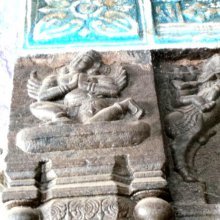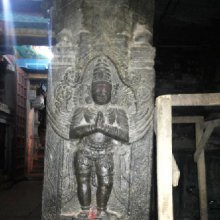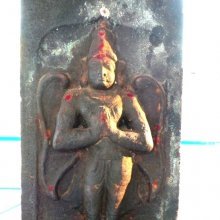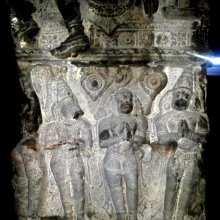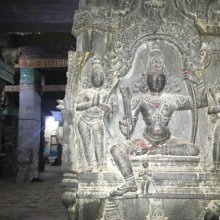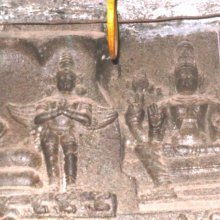Anjalihasta, Añjalihasta, Anjali-hasta: 3 definitions
Introduction:
Anjalihasta means something in Hinduism, Sanskrit. If you want to know the exact meaning, history, etymology or English translation of this term then check out the descriptions on this page. Add your comment or reference to a book if you want to contribute to this summary article.
Images (photo gallery)
(+4 more images available)
In Hinduism
Shilpashastra (iconography)
Source: Google Books: Elements of Hindu iconographyAñjalihasta (अञ्जलिहस्त).—In this hand-pose the palms of the hands are kept close to each other and the folded-hands are made to rest on the chest. This hand-pose is indicative of worship and prayerfulness (see the picture of Hanuman given elsewhere).
Source: Shodhganga: The significance of the mūla-beras (śilpa)Añjalihasta (अञ्जलिहस्त) or simply Añjali refers to “devotion” and represents one of the four gestures with both hands, as defined according to texts dealing with śilpa (arts and crafs), known as śilpaśāstras.—Accordingly, pratimā-lakṣaṇa (body postures of the icons) is comprised of hand gestures (hasta, mudrā or kai-amaiti), stances/poses (āsanas) and inflexions of the body (bhaṅgas). There are thirty-two types of hands [viz., añjalihasta] classified into two major groups known as tolirkai (functional and expressive gestures) and elirkai (graceful posture of the hand).
(Description of Añjali-hasta): When both the hands in abhaya-hasta are held close together at the level of the chest, it is known as añjali-hasta.

Shilpashastra (शिल्पशास्त्र, śilpaśāstra) represents the ancient Indian science (shastra) of creative arts (shilpa) such as sculpture, iconography and painting. Closely related to Vastushastra (architecture), they often share the same literature.
Natyashastra (theatrics and dramaturgy)
Source: Shodhganga: Elements of Art and Architecture in the Trtiyakhanda of the Visnudharmottarapurana (natya)Añjalihasta (अञ्जलिहस्त) or simply Añjali refers to one of the thirteen Saṃyuktahastas or “combined hand gestures” (in Indian Dramas), according to the Viṣṇudharmottarapurāṇa, an ancient Sanskrit text which (being encyclopedic in nature) deals with a variety of cultural topics such as arts, architecture, music, grammar and astronomy.—The hasta-mudrās (lit. “hand-gestures”) are very essential to denote some particular action or state in dancing and these mudrās are formed with the help of hands and fingers. In the Viṣṇudharmottarapurāṇa, thirteen kinds of saṃyuktahastas (“dancing postures made by combined hands”) are mentioned. e.g., añjalihasta.

Natyashastra (नाट्यशास्त्र, nāṭyaśāstra) refers to both the ancient Indian tradition (shastra) of performing arts, (natya—theatrics, drama, dance, music), as well as the name of a Sanskrit work dealing with these subjects. It also teaches the rules for composing Dramatic plays (nataka), construction and performance of Theater, and Poetic works (kavya).
See also (Relevant definitions)
Partial matches: Hasta, Anjali.
Full-text: Anjali, Ketu, Anjaneya, Bharata, Mohenjo-daro, Vyaghrapada, Patanjali, Parthasarathi, Lakshmana, Garuda, Varaha, Narasimha, Hanuman, Linga, Kamakshi.
Relevant text
Search found 6 books and stories containing Anjalihasta, Añjalihasta, Anjali-hasta, Añjali-hasta; (plurals include: Anjalihastas, Añjalihastas, hastas). You can also click to the full overview containing English textual excerpts. Below are direct links for the most relevant articles:
Jainism in Odisha (Orissa) (by Ashis Ranjan Sahoo)
Santinatha image at Khandeswara Temple, Nasik < [Chapter 3: Survey of Jaina Antiquities in Odisha]
Jaina Antiquities in Prachi Valley (Cuttack) < [Chapter 3: Survey of Jaina Antiquities in Odisha]
Jaina Temples at Subei (Koraput) < [Chapter 3: Survey of Jaina Antiquities in Odisha]
Temples of Munnur (Historical Study) (by R. Muthuraman)
Other Images < [Chapter 5]
Later Chola Temples (by S. R. Balasubrahmanyam)
Temples in (Ten-) Tiruvalangadu < [Chapter XII - Temples of Kulottunga III’s Time]
Temples in and around Madurantakam (by B. Mekala)
Kodandarama or Kothandarama Perumal Temple—Madurantakam < [Chapter 4 - Prominent Temples in Madurantakam Taluk]
Atcheeswarar Temple at Acharapakkam < [Chapter 4 - Prominent Temples in Madurantakam Taluk]
Sri Venkateswarar Temple < [Chapter 4 - Prominent Temples in Madurantakam Taluk]
Gati in Theory and Practice (by Dr. Sujatha Mohan)
Gati used for the delineation of Bhāva and Rasa < [Chapter 3 - Application of gati in Dṛśya-kāvyas]
South Indian Portraits < [May, 1928]
Related products
